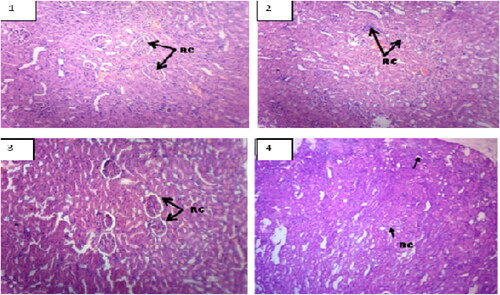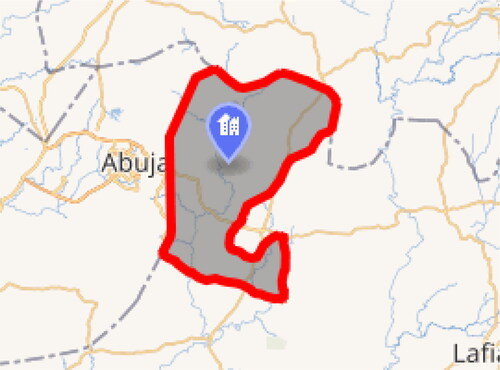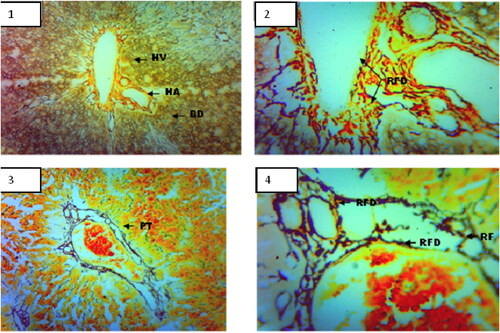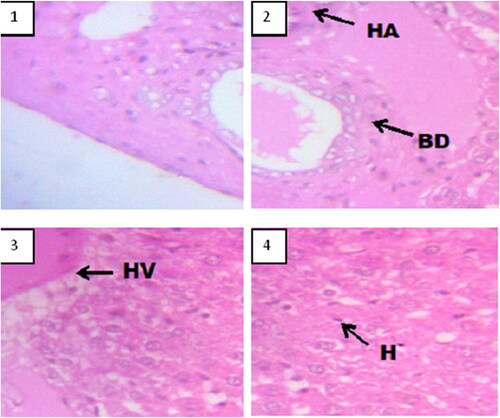Abstract
In this study, the effects of subacute Pterocarpus santalinus (rosewood) consumption on lung, brain, stomach, and hematological parameters in Wistar rats were evaluated. Mice of both sexes were used in the experiment. Groups 2, 3, and 4 were given 100, 200, and 400 mg/kg of red sandalwood, and group 1 was given distilled water (10 ml/kg). Animals were kept in standard cages for 28 days and extracts were taken orally before being weighed and sacrificed. Histological analysis was performed using the hematoxylin and eosin (H&E) staining technique. The brain, spleen, and stomach were also carefully removed and examined histologically. RBC, HGB, and MCV decreased slightly (P < 0.05), but there was no change in neutrophils, basophils, eosinophils, or platelets. No significant (P < 0.05) changes were observed in the brain, spleen, and stomach of mice in all dose groups. Lung histopathological analysis showed no difference in alveolitis and perivasculitis at doses of 100 and 200 mg/kg, but there were no changes in the brain and intestines. The plant is also safe to eat. Due to minor hematological effects, caution is advised with long-term use.
REVIEWING EDITOR:
1. Introduction
The lungs are the most important organ of the respiratory system and are divided into sections called lobes. The right lung has three lobes; it has one more lobe than the left lung, which has two lobes. The mediastinum separates the lungs (Morais et al., Citation2022). This area includes the heart, trachea, esophagus, and various lymph nodes. The lungs are protected by the pleura and separated from the abdominal cavity by the diaphragm muscle. With each breath, air moves through the esophagus into the lungs (bronchi) and into hundreds of tiny sacs (alveoli) at the ends of the bronchi. These fruit-like sacs are surrounded by small blood vessels called capillaries (Joseph et al., Citation2019). The brain, which is the control center of the body, receives and sends messages to other organs through the nervous system and the hormones secreted by the body (Batista et al., Citation2022; Joseph et al., Citation2018; Sima et al., Citation2023). It controls how we think, reflect, remember things, and see the world. The stomach secretes digestive enzymes and acids. Wrinkles are folds of the muscles covering the stomach. For good digestion, food is mixed by contraction of the stomach muscles. The pyloric sphincter, a muscle, opens and allows food to pass from the stomach to the intestines. The spleen is the largest organ in the lymphatic system. Although it is an important organ in preserving body fluids, it is possible to survive without it (Silva et al., Citation2023). Rosewood is a small tree with a height of up to 8 meters and a trunk diameter of 50 to 150 cm. It grows rapidly when young, reaching a height of 5 meters in three years, even in degraded soil. It is not frost resistant and kills at 1 °C.
Sandalwood Pterocarpus santalinus is a small to medium-sized tree from the Leguminosae family (Krishnamoorthy et al., Citation2003; Devi and Basha Citation2012). It has spread to many parts of the world, including India, Sri Lanka, Saudi Arabia, Taiwan, and China (Krishnamoorthy et al., Citation2003; Senes-Lopes et al., Citation2023). The leaves are triple and alternate, approximately 3 to 9 cm long. The flowers are in separate groups. The fruits are 6 to 9 cm long pods containing one to two seeds. In traditional phytotherapy, Pterostilbene is used as an antipyretic, anti-inflammatory, anthelmintic, tonic, antihemorrhagic, antistatic, aphrodisiac, hypoglycemic, and diaphoretic agent (Dutta et al., Citation2004; Mohire et al., Citation2007). Pterocarpus santalinus (Pterocarpus santalinus) is a medicinal plant rich in flavonoids and phenolics used for many purposes in medicine (Dutta et al., 2004). The aim of this study was to evaluate the subacute toxicity of ethanolic extract of Pterostilbene leaves in the brain, stomach, and spleen of Wister rats.
2. Materials and method
2.1. Study area
The study was conducted at Bingham University, Karu, Nasarawa State Nigeria between 10 June 2021 and 30 July 2021. The Bingham University is located at Abuja-Keffi Rd, 961105, Karu, Nasarawa Karu has a latitde of 9°2’1.25"N and logitude of 7°36’2.08"E or 9.03368, and 7.600579, respectively. Karu LGA has a total area of 2640 square kilometers with an average temperature of 29 degrees Celsius. The region is expected to receive 1250 mm of annual rainfall, with an average wind speed of 9 km/h for the local government area. The map of the study area is indicated in .
2.2. Animals
Male and female Wister rats were obtained from Bingham University Animal House. They were fed standard Grand Cereals animal pellets and given unlimited water. Bingham University Faculty of Health Sciences Ethics Committee approved and approved the animal experiments (BU/2021/1132). Mice (n = 6) were placed in different treatment groups. Animal experiments were carried out under the same conditions. The care and handling of animals complies with public health guidelines in the Guide for the Care and Use of Livestock (2011).
2.3. Plant collection
The fresh leaves of the rosewood are collected from places near Karu village in Nasarawa State, Nigeria. The plants were approved by the Department of Botany, Bingham University, Nasarawa State, Nigeria. It was assigned a serial number (BU1189).
2.4. Plants extraction
Pterocarpus santalinus was dried in a cool place for two weeks. The dried plant material was then crushed and cut into small pieces. Extraction was carried out at room temperature using 70% ethanol using 200 g of extract per liter of ethanol. The liquid filtrate was concentrated and evaporated to dryness under vacuum at 40 °C using a field evaporator. Ethanol extracts were stored at −4 °C until use.
2.5. Animal testing
Organization for Economic Development (OECD) Guide No. 425 was employed (OECD, Citation2008). Twenty-four (24) mice (weight 190 to 289 g) of both sexes were selected. The extract was given to the rats in groups 2, 3, and 4 at doses of 100, 200, and 400 mg/kg, respectively, while group 1 was the control group and received physiological saline (10 ml/kg). The body weight of the mice was recorded at the beginning of the experiment and once a week thereafter. The anesthesia day was determined as D29 and the application day was determined as D0.
2.6. Hematological analysis
Accordingly, the mice were sacrificed with diethylether on the 29th day of this study. A blood sample is taken slowly from the heart. Collect blood into EDTA sample vials for hematology analysis, including heme concentration, white blood cell (WBC) count, differential count (neutrophils, eosinophils, basophils, lymphocytes, and monocytes), red blood cells (RBC), platelets, and hemoglobin suitable) focus). This was done using an automated hematology machine (Cell-Dyn, Abbott, USA).
2.7. Food and water intake
When calculating daily food and water intake, the difference between daily food and water intake and the amount remaining after 24 hours was used. On day 29 of the experiment, mice were sacrificed and organs were removed for further histopathological analysis.
2.8. Experimental data
(food intake, body weight gain, organ weight ratio and hematological examination) were entered into a Microsoft Excel spreadsheet and submitted for one-way ANOVA using SAS (Citation2011, version 9).3). The Tukey test (, 0.05) was used to differentiate the treatment measures. To compare treatments, intermediate contrasts were performed.
3. Result
3.1. Effect of oral administration of Pterocarpus santalinus for 28 days on hematological parameters in rats
Pterocarpus santalinus caused a slight decrease (P < 0.05) in the levels of red blood cells, hemoglobin, and platelets, etc., and a significant increase (P < 0.05) in the mean corpuscular hemoglobin concentration in rats at a dose of 200 mg (). Dose level/kg compared to control. However, the mean corpuscular hemoglobin concentration had no influence on basophils, neutrophils, eosinophils, or lymphocytes (p < 0.05) ().
Table 1. Effect of leaf extract of Pterocarpus santalinus on hematological parameters in Wister rats.
3.2. Effect of Pterocarpus santalinus on body weight (g) in rats
At a dose of 200 mg/kg, the ethanolic extract of Pterocarpus santalinus leaves caused a significant effect (P < 0.05) Weight gain in the first, third and fourth weeks, but not in the second week compared to the control group ().
Table 2. Effect of Pterocarpus santalinus on body weight (g) in rats.
3.3. Effect of Pterocarpus santalinus on the relative body/organ weight ratio in rats
Rats that received 400 mg/kg plant extract in the form of ethanol had significant (P < 0.05) larger brains, lungs, and stomachs. No significant difference was found at lower doses of 100 and 200 mg/kg (P < 0.05) ().
Table 3. Effect of Pterocarpus santalinus on relative organ to body weight ratio in rats.
3.4. Effect of Pterocarpus santalinus on histology of lungs, brain, and stomach of rats
The histological study of the brain indicated normal histopathological features at all doses and a modest amount of vacuolation at the 100 mg/kg extract dose. For each dose, the lungs revealed normal characteristics. The lung histopathology assessment revealed that at 100 and mg/kg there was no significant differences in alveolitis and perivasculitis. The stomach displayed typical features at all doses of the extract administered ().
Figure 2. Figure of the brain (Hematoxylin and eosin. H and E × 100). (1) Control group, shows normal neurons (N), (2) 50 mg/kg, (3) 100 mg/kg, and (4) 200 mg/kg of ethanol stem extract of Pterocarpus santalinus.

4. Discussion
Studies have shown that rosewood leaf extract reduces red blood cell count, hemoglobin, hematocrit, and the average hemoglobin concentration in blood cells, but has no effect on neutrophils, basophils, eosinophils, or platelets. This indicates that this reduces the blood’s ability to carry oxygen, resulting in blood deficiency. Hematological indices can be used as important markers to evaluate the toxicity of plant extracts in living organisms (Pathan et al., Citation2013; Sathishkumar & Baskar, Citation2014). They can also be used to identify the effects of chemical molecules or plant extracts in the blood. Anemia is a condition in which the blood does not have enough hemoglobin, an iron-rich protein that carries oxygen to red blood cells and provides energy to the body, or not enough red blood cells carry oxygen from the lungs to the rest of the body. hole. Body. There are different types of diabetes that vary in severity and duration (Duke, Citation2012; Krenzelok Citation2003; Senes-Lopes et al., Citation2023). Decreases in red blood cell (RBC) count and hematocrit (PCV) were also observed in treated rats. This suggests that Pterocarpus santalinus may affect the osmotic control mechanism of blood cells and/or cause oxidative damage to cell membranes. The extract can inhibit the activity of the hematopoietic system. The breakdown of blood cells may also cause this decrease. Mice given the extract showed a decrease in red blood cells, PCV, hemoglobin and lymphocytes. The main functions and changes of white blood cells include fighting, protecting the body from foreign organisms through phagocytosis, and participating in other biological processes, and the body (Nascimento et al., Citation2022). The lack of changes in neutrophils, basophils and eosinophils indicates that the extract has no effect on humoral immunity. Platelets are small cells that play an important role in the body because they are part of the blood clotting process. The results of the study show that the ethanol extract of rosewood has no direct or indirect effect on fibrin clot production.
This study showed that mice treated with ethanol extract of stomach, brain and lung of P santalinus for 28 days had normal characteristics. No damage (pathological change) was observed in the tissues of animals receiving different doses of extract. The present observations are consistent with previous studies on the biochemical response of albino Wister rats exposed to pterostilbene (Haruna et al., Citation2020; Mishra et al., Citation2013; Wazis et al., Citation2020).
The lungs, which are the respiratory system, consist of a pair of organ-like organs located in the chest cavity and separated from each other by the heart and other mediastinal organs (Sathishkumar & Baskar, Citation2014). Lungs are the main organs of the lungs and their main function is to facilitate gas exchange from the environment to the blood. Oxygen is transported from the alveoli to the capillary network, from where it enters the blood vessels and eventually travels through the tissues. Asthma, pneumothorax or atelectasis, bronchitis, chronic obstructive pulmonary disease, lung cancer, pneumonia, pneumonia and pulmonary edema (Pathan et al., Citation2013). The harmony of hematological parameters and histological values shows that the plant does not cause apoptosis or tissue necrosis.
Finally, when tested on mice, rosewood water extract had no effect on body tissues. Further subcellular studies and characterization of the active compounds found in aqueous extracts of rosewood are needed. Additionally, studies have shown that fresh and dried sandalwood (Pterocarpus santalinus) samples contain alkaloids, flavonoids, glycosides, saponins, tannins, phenols and triterpenoids. (Joseph et al., Citation2021; Joseph & Opeyemi, Citation2021). The antioxidant properties of plant molecules such as saponins, tannins, phenols, and triterpenoids may help reduce the effects of tissue damage.
5. Conclusion
The results showed that Pterocarpus santalinus also known as red sandalwood had no significant side effects at low and moderate doses and was therefore safe for frequent and regular use. More research is needed to determine organic conservation of these plants.
Authors’ contributions
All authors were involved in designing the protocol for the research. They were also responsible for interpreting of results and writing of the manuscript.
| Abbreviations | ||
| PS | = | Pterocarpus santalinus |
| DW | = | distilled water |
| WBC | = | white blood cells |
| RBC | = | red blood cells |
| HGB | = | hemoglobin |
| HCT | = | hematocrit |
| MCV | = | mean corpuscular volume |
| MCH | = | mean corpuscular hemoglobin |
| MCHC | = | mean corpuscular hemoglobin concentration |
| PLT | = | platelet |
| LYM | = | lymphocyte |
| NEUT | = | neutrophils |
| EOSI | = | eosinophils |
| BASO | = | basophils |
biography.docx
Download MS Word (18.5 KB)Acknowledgement
The authors would like to extend their gratitude to King Saud University (Riyadh, Saudi Arabia) for funding this research through Researchers supporting Project number RSP2024 R406.
Disclosure statement
The authors declare that there are not any potential conflicts of interest.
Correction Statement
This article has been corrected with minor changes. These changes do not impact the academic content of the article.
Additional information
Notes on contributors

Oyepata Simeon Joseph
Oyepata Simeon Joseph is currently with Federal University Oye-Ekiti (FUOYE), Ekiti State, Nigeria. He had his first degree as B.Pharm, a Master degree in Pharmacology and Ph.D in Pharmacology and Toxicology. He is currently a Lecturer and researcher at FUOYE. Also, he has done and published research works that are very relevant to the past, present, and future. Many of these works have been published and recognized in relevant journals and research sites. He is a passionate philosopher and researcher interested in ethnopharmacology, toxicology, clinical, genetic, molecular, and natural Science.
References
- Batista, D., Romáryo Duarte da Luz, J., Evellyn Silva Do Nascimento, T., Felipe de Senes-Lopes, T., Araújo Galdino, O., Victor E Silva, S., Pinheiro Ferreira, M., Arrison Dos Santos Azevedo, M., Brandão-Neto, J., Araujo-Silva, G., López, J. A., & das Graças Almeida, M. (2022). Licania rigida leaf extract: Protective effect on oxidative stress, associated with cytotoxic, mutagenic and preclinical aspects. Journal of Toxicology and Environmental Health. Part A, 85(7), 1–7. https://doi.org/10.1080/15287394.2021.2002744
- Devi R. K., Basha S. K. 2012 Comparative amino acid profiling of pterocarpus santalinus and boswelia ovalifoliolata barks of Tirumala Hills, Eastern Ghats, Andhra Pradesh. Int J Basic App Chem Sci. 2:102–6.
- Duke, J. (2012). Handbook of Legumes of World Economic Importance. Springer Science & Business Media. p. 49.
- Dutta, P. K., Dutta, J. 2004. Tripathi VS. Chitin and chitosan: chemistry, properties and applications. J Sci Ind Res. 63:20–31.
- Haruna, W. C., Builders, M., Simeon, J. O., & Tosin, J. O. (2020). Toxicological study of the effect of ethanol leaf extract of Pterocarpus santalinus extract on liver of Wister rats. Nigeria Biomedical Science Journal, 17–29.
- Joseph, O. S., Builders, M., Emem, E. U., & Joseph, O. T. (2019). Effect of ethanol leaf extract of cassia angustifolia extract on liver of Wister rats. Global Scientific Journal, 8(9), 1112–11120.
- Joseph, O. S., Builders, M., Emem, E. U., & Joseph, O. T. (2019). Effect of ethanol leaf extract of Cassia angustifolia extract on kidney of Wister Rats. Global Scientific Journal, 7(10), 106–122.
- Joseph, O. S., Builders, M., Joseph, O. T., Famojuro, T. I., Ogira, J. O., Moses, F. D., & Musa, T. L. (2021). Effect of the Demographic of Covid-19 on Different Countries; Using the USA for Comparism. International journal of multidisciplinary research and analysis. Volume 04 Issue 02. 193–203.
- Joseph, O. S., Jude, E. O., & Joseph, O. T. (2018). Hepatoprotective activity of extract of Homalium Letestui stem against carbon tetrachloride-induced liver injury. Advance Herbal Medicine, 4(4), 1–11.
- Joseph, S. O., & Opeyemi, J. T. (2021). Effect of clinical study of Moringa oleifera on body mass index, low density lipoprotein and Triglyceride level in patients on tenofovir/lamivudine/efavirenz combination therapy. Advanced Herbal Med, 6(1), 14–27.
- Krenzelok, E. p., Anderson, D. l., Ryan, M. l. (May 2003). Skin breakdown and blisters from senna-containing laxatives in young children, The Annals of Pharmacotherapy, 37 (5): 636–9.
- Krishnamoorthy, P., Stella, J., Mohamed, A. J., & Anand, M. (2003). Radical scavenging and antibacterial evaluation of Pterocarpus santalinus leaf in-vitro study. International Journal of Pharmaceutical Sciences and Research, 2, 1204–1208.
- Mishra, A., Srivastava, R., Strivastava, S. P., Gautam, S., Tamrakar, A. K., Maurya, R., & Strivastava, A. K. (2013). Antidiabetic activity of heart wood of Pterocarpus marsupium Roxb. and analysis of phytoconstituents. Indian Journal of Experimental Biology, 51(5), 363–374.
- Mohire, N. C., Salunke, V. R., Bhinse, S. B., & Yadav, A. V. (2007). Cardiotonic activity of aqueous extract of heartwood of Pterocarpus marsupium. Indian Journal of Experimental Biology, 45, 532–537.
- Morais, L. V. F., Luz, J. R. D. D., Nascimento, T. E. S. D., Azevedo, M. A. D. S., Rocha, W. P. D. S., Araujo-Silva, G., Ururahy, M. A. G., Chaves, G. M., Brandão-Neto, J., López, J. A., Dos Santos, E. C. G., & Almeida, M. D. G. (2022). Phenolic Composition, toxicity potential, and antimicrobial activity of Licania rigida Benth (Chrysobalanaceae) leaf extracts. Journal of Medicinal Food, 25(1), 97–109. https://doi.org/10.1089/jmf.2021.0059
- Nascimento, T. E. S. D., López, J. A., Barbosa, E. A., Ururahy, M. A. G., Brito, A. D. S., Araujo-Silva, G., Luz, J. R. D. D., & Almeida, M. D. G. (2022). Mass spectrometric identification of Licania rigida Benth leaf extracts and evaluation of their therapeutic effects on lipopolysaccharide-induced inflammatory response. Molecules (Basel, Switzerland), 27(19), 6291. https://doi.org/10.3390/molecules27196291
- OECD. (2008). Test No. 407: Repeated Dose 28-day Oral Toxicity Study in Rodents, OECD Guidelines for the Testing of Chemicals. Section 4, OECD Publishing. https://doi.org/10.1787/9789264070684-en
- Pathan, M. M., Khan, M. A., Moregaonkar, S. D., Somkuwar, A. P., & Gaikwad, N. Z. (2013). Amelioration of paracetamol induced nephrotoxicity by Maytenus emarginata in male Wister rats. International Journal of Pharmacy and Pharmaceutical Sciences. 5, 471–474.
- Sathishkumar, T., & Baskar, R. (2014). Renoprotective effect of Tabernaemontana heyneana Wall. leaves against paracetamol-induced renotoxicity in rats and detection of polyphenols by high-performance liquid chromatography-diode array detector-mass spectrometry analysis. Journal of Acute Medicine, 4(2), 57–67. https://doi.org/10.1016/j.jacme.2014.02.002
- Senes-Lopes, T. F., Luz, J. R. D. D., Guterres, Z. D. R., Barbosa, E. A., Batista, D., Galdino, O. A., Ururahy, M. A. G., Gomes Dos Santos, E. C., López, J. A., Araujo-Silva, G., & Almeida, M. D. G. (2023). Pseudobombax parvifolium hydroalcoholic bark extract: Chemical characterisation and cytotoxic, mutagenic, and preclinical aspects associated with a protective effect on oxidative stress. Metabolites, 13(6), 748. https://doi.org/10.3390/metabo13060748
- Silva, I. C. A., Azevedo, L. S., Castro, A. H. F., Farias, K. S., Zanuncio, V. S. S., Silva, D. B., & Lima, L. A. R. D. S. (2023). Chemical profile, antioxidant potential and toxicity of Smilax brasiliensis Sprengel (Smilacaceae) stems. Food Research International (Ottawa, Ont.), 168, 112781. https://doi.org/10.1016/j.foodres.2023.112781
- Sima, O. C., Ndong, M. T., Ondo, J. P., Ngoua Meye, M. R. L., Orango, B. J. O., Otogo N’Nang, E., Mbogho, A. J., Jolinom, M. E., Obame, E. L. C., & Nsi, E. E. (2023). Toxicity, antibacterial, and phytochemical analyses of Antrocaryon klaineanum Pierre extracts. Advances in Pharmacological and Pharmaceutical Sciences, 2023, 9304681. https://doi.org/10.1155/2023/9304681
- Wazis, C. H., Joseph, O. S., Modupe, B., & Joseph, O. P. (2020). Effect of ethanol leaf extract of Pterocarpus santalinus extract on kidney of Wister Rats. Nigerian Biomedical Science Journal, 17(1), 35–47.




